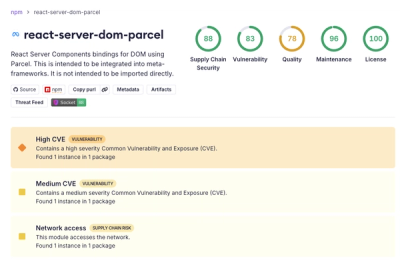
Security News
New React Server Components Vulnerabilities: DoS and Source Code Exposure
New DoS and source code exposure bugs in React Server Components and Next.js: what’s affected and how to update safely.
TemplateRex
Advanced tools
TemplateRex is a pure template engine that has no embedded logic and is written in Python - small and fast.
First order is KISS - keep it simple. Second is to strive to keep logic together in the logic domain handled by a first class scripting language and content/presentation (html,xml) in the presentation domain.
Invariably template engines that embed logic/code within html continue to add functionality to the point where they themselves become a complex programming environment which is less functional but more complex and cryptic than the underlying python language itself - violating the KISS principle and raising the learning curve.
TemplateRex templates are fully viewable in a browser or WYSIWYG editor. This facilitates divsion of labor by allowing front-end designers and back-end developers to work seperately - and not introduce security issues.
This approach often results in dry'er code due to seperation of domains. For example a common core code base could serve up completely different look and feel presentations and data scope by using diifferent templates sets without a single for-loop or if-clause repeated.
There are other benefits refer to the paper "Enforcing Strict Model-View Separation in Template Engines" by Terence Parr University of San Francisco
Here is a small hello world example.
Python Code::
# --- Python Code ----
from templaterex import TemplateRex
trex = TemplateRex(fname='t-mytemplate.html')
row = [ {'cellId:'A123','volt':1.21}, {'cellId:'B321','volt':1.52} ]
for row in row_data:
trex.render_sec('row', row )
trex.render_sec('tbl',{'category':'List of Usernames'})
rendered_str = trex.render()
# ---------------------
Template text::
# --- Template t-mytemplate.html --------
<!doctype html>
<html>
<head>...</head>
<body>
<table>
<tr><th>Cell ID </th><th> Voltage </th></tr>
<!-- BEGIN=row -->
<tr><td>$cellId </td><td> $volt </td></tr>
<!-- END=row -->
</table>
</body>
</html>
# ---------------------
As shown text blocks are bracketed with BEGIN=name/END=name delimiters placed inside html comments. Note the END delimiter is named which helps with fast comprehension of complex templates.
Text in these blocks (or sections) are rendered via a call to render_sec(block_name,context). The overall or base template is rendered with a call to render(). These blocks can be hierarchically specified for example.
Python code::
# --- Python Code ----
from templaterex import TemplateRex
trex = TemplateRex(fname='t-mytemplate.html')
row = [ {'username:'Mary'},{'username':'Sam'} ]
bat_lo_cell = [{ 'cellId':321,'volt':1.5}, { 'cellId':101,'volt':1.7}] }
bat_hi_cell = [{ 'cellId':102,'volt':2.5}, { 'cellId':141,'volt':2.7}] }
for row in bat_lo_cell:
trex.render_sec('row', row )
trex.render_sec('tbl', {'caption': 'Low Cells' } )
for row in bat_hi_cell:
trex.render_sec('row', row )
trex.render_sec('tbl', {'caption': 'High Cells' } )
rendered_str = trex.render()
# ---------------------
Template text::
# --- Template t-mytemplate.html --------
... surrounding html ...
<!-- BEGIN=tbl -->
<table>
<caption>$caption</caption>
<tr><th>Cell ID</th><th>Voltage</th></tr>
<!-- BEGIN=row -->
<tr><td>$cellId </td><td> $volt</td></tr>
<!-- END=row -->
</table>
<!-- END=tbl -->
... surrounding html ...
# ---------------------
This will render two tables one following the other with the unique caption and data. Of course this could be done with a nested for-loop but given as is for clarity.
Template Inheritance
You can specify a base or layout template. If the first line in a template
call contains a BASE specifier such as
<!-- BASE=t-layout.html -->
The template algorithm will search the path for the base
template as specified and parses this template first.
Called Template text::
# --- Template t-mytemplate.html --------
<!-- BASE=t-layout.html -->
<!-- BEGIN=content -->
<div class="conent">
... content here ...
</div>
<!-- END=content -->
... surrounding html ...
# ---------------------
Base Template text::
# --- Template t-layout.html --------
<!doctype html>
<html>
<head>...</head>
<script type="text/javascript" src="../static/jquery.js"></script>
<link rel="stylesheet" href="../static/style.css" type="text/css" />
<body>
<header> ...heading stuff... </header>
$content
<footer> ...footing stuff... </footer>
</body>
</html>
Python Code::
# --- Python Code ----
from templaterex import TemplateRex
trex = TemplateRex(fname='t-mytemplate.html')
....
trex.render_sec('content', context_dict)
....
rendered_str = trex.render()
# ---------------------
Template Includes
~~~~~~~~~~~~~~~~~
Another basic capability is to include snippets within a templates. If
during processing an include statement is encountered such as
<!- INCLUDE=t-header.html -->
The contents of that template are included in the calling template
Function/Filters
Functions (sometimes called filters in other template engines) calls can be specified within the template text with the following syntax::
&function_to_be called($args1,'arg2',kwarg1=True,kwarg2='test')
The function name (behind the &) has to be either one of the builtin functions or a custom registered function call. If a function does not have args the follwing matching parenthesis are required.
The args can either be string literals identified with quotes, True or False booleans, integer or floating point numbers or a context variable. Context variables are identified with either a leading $ or just bare word - using the $ delimiter is faster and encouraged for clarity. If a context variable is not found in the context the function call is silent.
Functions can be easily registered in two ways. The easiest is to specify custom functions during object creation the func_reg keyword.
For example::
func_custom_dict = {'format':format, 'myfunc':myfunc}
trex = TemplateRex(fname=fspec_template, func_reg=func_custom_dict)
Which is equivalent to::
func_custom_dict = {'format':format, 'myfunc':myfunc}
trex = TemplateRex()
trex.functions.update( func_custom_dict )
trex.get_template(fspec_template)
would register the python format function and your own custom myfunc function. Then you could use the following in your template:
Voltage is: &format($voltage,'.1f')
Where voltage is a context variable and needs to be passed in the context dictionary of the render call (either render_sec() or render() ) where the function is exists.
Builtin Function/Filters
TBD - look in functions.py for code
Options: Comment Character(s)
HTML comment characters for specifying section blocks are the default . However these are selectable. For example, here is an object creation with different comment prefix and postfix characters options::
trex = TemplateRex(fname='dhcpcd-template.conf',cmnt_prefix='##-',cmnt_postfix='-##')
This will parse the template looking for section blocks delimited as::
##- BEGIN=static_section -##
... section block ...
##- END=static_section -##
Options: Development or Verbose Mode
Sometimes it is convienent to see what the file source of the templates used in rendered template outputs. This mode can be selected with a dev_mode argument. For example::
trex = TemplateRex(fname='/etc/dhcpcd-template.conf',cmnt_prefix='##-',cmnt_postfix='-##',dev_mode=True)
When the template is rendered on this object there will be commented hints about the location and section of templates used such as::
##- Template:/etc/dhcpcd-template.conf Section:static_section Below -##
interface eth0
static ip_address=10.10.80.202/24
static routers=10.10.80.1
static domain_name_servers=192.168.101.210
##- Template:/etc/dhcpcd-template.conf Section:static_section Above -##
FAQs
KISS Pure Logicless Template Engine
We found that TemplateRex demonstrated a healthy version release cadence and project activity because the last version was released less than a year ago. It has 1 open source maintainer collaborating on the project.
Did you know?

Socket for GitHub automatically highlights issues in each pull request and monitors the health of all your open source dependencies. Discover the contents of your packages and block harmful activity before you install or update your dependencies.

Security News
New DoS and source code exposure bugs in React Server Components and Next.js: what’s affected and how to update safely.

Security News
Socket CEO Feross Aboukhadijeh joins Software Engineering Daily to discuss modern software supply chain attacks and rising AI-driven security risks.

Security News
GitHub has revoked npm classic tokens for publishing; maintainers must migrate, but OpenJS warns OIDC trusted publishing still has risky gaps for critical projects.